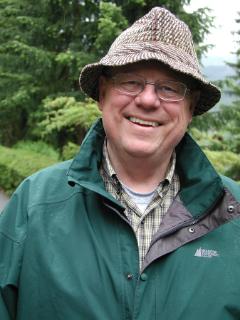Inland Fishings in Medieval Scotland
In Autumn 2011 Dr Alasdair Ross was awarded a grant by the Leverhulme Trust (Award ref: VP2-2010-032) to bring Professor Richard Hoffmann (right) to Stirling for an extended period of time. During his visit to Scotland Professor Hoffmann was engaged in both teaching and research. The latter involved primary research into monastic fish ponds and medieval riverine fisheries in Scotland, specifically those associated with salmon.

He had four broad remits:
- To conduct a series of Leverhulme lectures at four Scottish universities (Stirling, St Andrews, UHI and Edinburgh) on different aspects of Environmental History to help develop new research synergies.
- To bring his extensive knowledge and experience of medieval European fisheries and aquatic ecosystems to Scotland to investigate our medieval secular and ecclesiastic riverine fisheries via a combination of documentary research and field work.
- To stimulate a new research agenda by imparting his knowledge and skills to staff and students at the University of Stirling and elsewhere.
- To suggest future viable research projects to fully investigate riverine fisheries in Scotland.
We also undertook extensive fieldwork while Professor Hoffmann was resident in Scotland, visiting sites as far afield as the supposed fish pond beside Sweetheart Abbey, the secular fish pond at Craigmillar Castle, and a salmon cruive on the River Beauly.
Research Summary
Because so little has been written about medieval fisheries in Scotland, none which interacts with environmental history, I asked Professor Hoffmann to begin his research ab initio. To that end, and because of time constraints, he was tasked with covering our major medieval sources alone, including the Regesta Regum Scottorum series, selected surviving ecclesiastic cartularies, the online database of the Acts of the Scottish Parliament (http://www.rps.ac.uk/), and selected burgh records. This research program was completed on 29 November 2011. The major product of this documentary research, backed up with site visits, is that Professor Hoffmann is now convinced that medieval Scotland possessed no recognizable freshwater fish culture in terms of breeding ponds, most likely because of easy access to alternative sources of protein from substantial salmon fisheries and eel traps. Some of this protein was for domestic consumption but the vast majority appears to have been destined for export to European markets. Accordingly, there was no need for secular and ecclesiastic lords to invest in fish breeding and rearing facilities. This theory would also help explain the noticeable glut of legislation concerning the protection of riverine fish and fisheries in the records of the Scottish parliament, some of which appears to be unique in a European context and may in fact be the earliest legislation of its kind in Europe. Professor Hoffmann was able to utilize this information to inform and contextualize his own research and writing on the medieval fisheries of Europe.

A V-shaped cruive across the River Beauly
Towards the end of his research program Professor Hoffman began to focus on two specific sites. The first of these, the Cistercian Abbey at Coupar Angus (founded c.1161), owned extensive riverine and estuarine salmon and eel fisheries in Perthshire. The second focused upon the long-running (over 300 years) disputes between the burgh of Stirling and the Augustinian community at Cambuskenneth Abbey (founded c.1140) about the ownership and nature of the tidal salmon fisheries in the River Forth between Stirling and the Forth estuary. In both cases documentary research was complemented with field work and a number of medieval fishing stations and salmon cruives (wood and stone barriers across a river with fish traps above them) were identified for the first time. This indicates that the upstanding remains of more medieval riverine fishing sites may still exist than previously thought, and it also demonstrates the future potential of this kind of integrated research.
It is hoped these findings will form the basis of a new research agenda into medieval salmon fisheries in Scotland.
